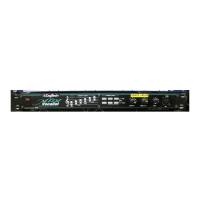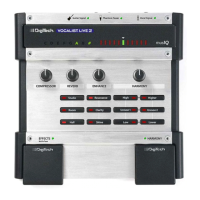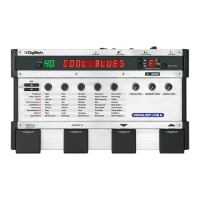14
The Vocalist Workstation EXÕs five basic harmony types are:
¥ Chordal These three Harmony types need musical
control from you as you are singing.
¥ Scalic
¥ Vocoder
¥ Chromatic These two Harmony types are for more
specific uses. Chromatic doesn't require
any special musical control. Used in Unison
presets to thicken the sound of the Lead vocal.
¥ Pitch Correct Pitch Correct can take input from a pitch bend
wheel, front panel keyboard or a MIDI note.
Chordal
You can tell a program is based on Chordal harmony when the upper right
hand character of the display shows a backlit ÒCÓ character. You will also
see first letter of the harmony style name shown in lower case letters (e.g.
maj, min, maj7). To use a Chordal harmony program, you must input each
chord in your song as it occurs. Chord input can come from chords you
play on a MIDI keyboard or from the front panel harmony controls. The
Vocalist Workstation EX has intelligent MIDI chord recognition to inter-
pret the chord inversions you play to produce correct harmonies.
A chord has two parts: the root note and the type. An example of this
would be an A major 7th chord which has ÒAÓ as its root and Òmajor 7thÓ
as its type.
Uses: provides a constant chordal harmony ÒbedÓ that stays on the current-
ly selected chord. Chordal harmonies automatically move harmony inter-
vals so that they sound correct over your lead voice melody.
For examples of Chordal harmony, choose any of the Factory Programs 16
through 25. Choose a root note on the front panel keyboard and sing. As
you sing, use the softkeys to switch between major, minor and the other
chord types, and listen to how the harmony voices change.
Style naming conventions: The first 3 to 4 characters of the name show
the chord type such as maj, min, dom7 etc. The 2 to 7 characters following
the chord type show the arrangement of the harmony voices above and
below your voice. The number with an arrow beside it shows how many
scale intervals away from the input note the harmony will be and whether
it is above or below. The B character shows that a bass voice is present that
will move less than the other voices. Fixed means that the harmony voices
will move less too.
Scalic
You can tell a program is based on Scalic harmonies when the upper right
hand character of the display shows a backlit ÒSÓ character. The first letter
of the harmony style name is capitalized (e.g. Maj1 and Min1). Scalic har-
mony programs require that you to enter the key and scale which usually
needs to be done only once at the beginning of your song. In western popu-
lar music, the chords often revolve around a single scale such as A major
where ÒAÓ is the key and ÒmajorÓ is the scale around which all the chords
of the song are centered.

